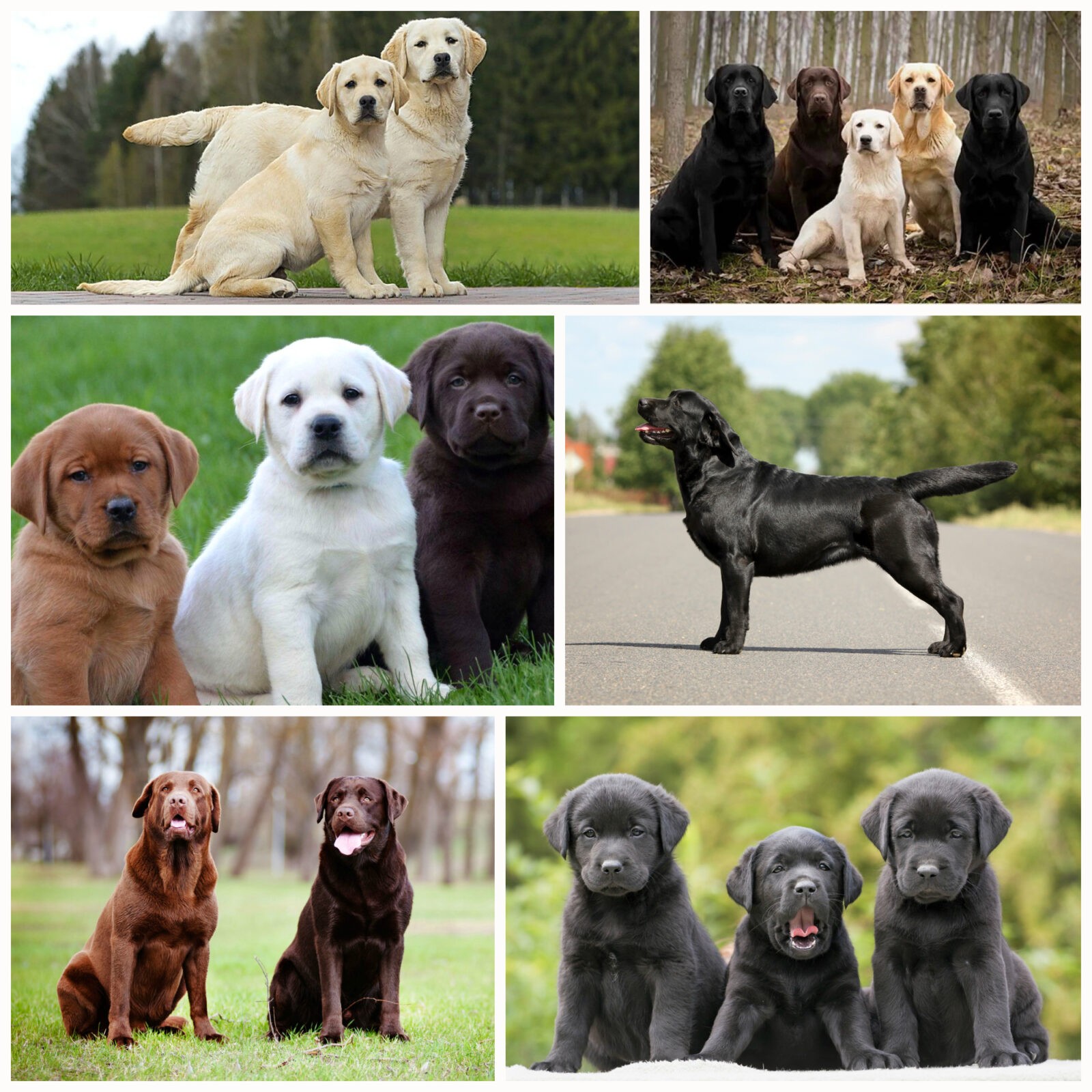The Labrador Retriever is bred as a working dog with a friendly disposition. Initially, these animals were indispensable helpers for fishermen. They helped haul fishing gear, retrieve fish from the cold waters of the North Atlantic.

Brief description of the breed
Labrador Today - This is an affectionate, good-natured dog, a reliable assistant and friend. These pets - the first helpers for people with disabilities. They take an active part in various search and rescue operations.
The Labrador is a sporting dog breed. The animal has a good character. The pet does not require excessive care. He is energetic and very attached to the person. The Labrador Retriever is distinguished by its devotion to the family. Many owners of these dogs compare them to real guardian angels.
The breed originated on the island of Newfoundland, located on the northeast coast of Canada. At first, the breed was called "St. John's dog". Labradors assisted local fishermen in their fishing, both at sea and on land.
Modern Labradors are no longer amenable to human exploitation. Now these pets - real family pets, surrounded by love and warmth. Although, in fairness, we note that Labradors are now happy to help their master - fisherman.
The gentle disposition of the Labrador has made him an excellent therapy dog. Animals provide psychotherapeutic assistance in orphanages, nursing homes, shelters. But a sharp mind made an excellent guide and a true professional in search and rescue of people out of a Labrador. The retriever is also popular among hunters. All thanks to the sharp sense of smell, fearless character and athletic physique of the animal.
According to dog breeders, the Labrador should not be used as a guard dog. They will not cope with this task because of their friendly mood towards a person. But as a companion dog, the Retriever is simply incomparable.
basic information
| Breed name: | Labrador retriever |
| Country of origin: | Canada |
| The time of the birth of the breed: | 19th century |
| Type of: | retrievers, spaniels and water dogs |
| The weight: | 26 - 40 kg |
| Height (height at the withers): | 55 - 57 cm |
| Life Expectancy: | 10 - 13 years old |
|
ICF classification:
|
Group 8, Section 1, Room 122 |
| Puppies price: | 200 – 1250 $ |
| Most popular nicknames: | list of nicknames for labrador |
Evaluation of the characteristics of the Labrador Retriever
| Adaptability
(a definition meaning how easily a dog can adapt to changes in life) |
🐶🐶🐶🐶🐶 |
| Shedding level
(Level and frequency of hair loss in the animal) |
🐶🐶🐶 |
| Tenderness level
(The level and amount of tenderness and affection that the dog gives in return for attention to itself) |
🐶🐶 |
| Exercise needs
(Dog's daytime activity level) |
🐶🐶🐶🐶🐶 |
| Social need
(The required number of contacts of the dog with other animals, as well as people) |
🐶🐶🐶🐶🐶 |
| Apartment content
(A factor that determines the level of noise and other inconveniences that a dog can deliver to owners in relation to the size of the apartment to the size of the dog) |
🐶🐶🐶🐶🐶 |
| Grooming
(The number of bathing, brushing, and the number of professional grooming sessions required for the dog) |
🐶 |
| Friendliness in an unfamiliar environment
(Features of the behavior of a dog in a society with strangers or in an unfamiliar environment) |
🐶🐶🐶🐶🐶 |
| Tendency to bark
(Tendency to bark and its frequency and volume) |
🐶🐶🐶 |
| Health issues
(Potential health status of the dog) |
🐶🐶🐶🐶 |
| Territoriality
(The dog's tendency to protect his home, yard, or even his owner's car) |
🐶🐶🐶 |
| Friendliness to cats
(The tendency towards tolerance for cats and decreased manifestation of hunting instincts) |
🐶🐶🐶🐶 |
| Intelligence
(The ability of the dog to think and solve emerging difficulties (not to be confused with learning!) |
🐶🐶🐶🐶🐶 |
| Education and training
(The level of difficulty in training the dog to perform certain actions) |
🐶🐶🐶🐶🐶 |
| Friendliness to children
(A factor that determines how friendly a dog is to children, whether he likes to play with them and tolerate some childish pranks) |
🐶🐶🐶🐶🐶 |
| Game activity
(The concept is determined by its very name, and, as a rule, is found in almost all dogs) |
🐶🐶🐶🐶🐶 |
| Observation
(The ability of a dog to detect the presence of a stranger on its territory) |
🐶🐶🐶 |
| Friendliness to other dogs
(The tendency of the dog to find common language with his other relatives) |
🐶🐶🐶🐶🐶 |
Labrador Retriever photo:

Origin story
Although the exact history of the origin of the Labrador is unknown, many believe that the animal appeared as a result of crossing the dog of St. John with local dogs. The amazing abilities of the Labrador did not go unnoticed. Therefore, later the Labrador Retriever appeared in England in the service of members of the royal family. The definition of the breed as a Labrador appeared in 1830. This name was the merit of the English Earl of Malmesbury.
Surprisingly, the Labrador Retriever is now one of the most popular dog breeds in the world. But back in the 1880s, these dogs were practically exterminated on the American continent. The breed also disappeared in Newfoundland itself. This was due to government tax restrictions. The family was allowed to keep no more than one dog, and the content dogs – females were taxed.
However, the breed was saved in England. In 1903, the Labrador Retriever was recognized as a separate breed by the Kennel Club. In 1903, the American Kennel Club followed the lead of the English Kennel Club and also recognized the breed. In the early 20s, mid-30s of the last century, active breeding of the breed began in America. The special popularity of the Labrador Retriever began after the Second World War. Peak of its popularity breed reached in 1991. It was then that the Labrador Retriever was recognized as the most popular breed in the United States.
The nature of the labrador
Maintenance and care
Training and education
Health and disease
Some interesting facts
- The Labrador Retriever originated on the island of Newfoundland, which is located northeast of the coast of Canada. In the 18th century, the dog was an indispensable assistant to the fishermen of the island. The animals worked all day long, helping the fishermen to catch fish and move heavy fishing gear, and in the evening the pets enjoyed spending time with their families.
- The Labrador Retriever loves to eat well. Therefore, the animal is prone to obesity. Be sure to control the nutrition of your pet, give him more physical activity. Do not forget that a large appetite is detrimental to the animal. You should also keep an eye on the Labrador and on the street, because he can eat food from garbage cans and food leftovers from other animals.
- Labrador Retrievers were bred specifically for hard physical work. Dogs are full of energy, so they need daily active exercise. The duration of such classes should be from 30 to 60 minutes. Without physical exertion, the dog will be forced to throw out unrealized energy on surrounding objects.
- The unsurpassed reputation of Labradors leads some people to believe that dogs of these breeds should not be trained at all. This opinion is wrong! The process of training and socialization must begin from the first days of the appearance of a puppy in the house.
- Labradors are very active. This is especially evident at an early age. In the process of growing up, the dog will become calmer, but the animal will never become passive. Labradors remain active throughout their lives.
- The combination of a boundless love for food and a keen sense of smell in a Labrador - potential nuisance for the owner. Your pet, smelling the smell of treats, can rush in search of him!
- The popularity of the Labrador provoked the emergence of negligent dog breeders who seek to breed more puppies, while not worrying about their health. Therefore, do not resort to the services of random breeders. Buy puppies only from trusted breeders. This will protect you and your pet from the occurrence of various diseases, possibly even genetic ones.
- When deciding to purchase a Labrador Retriever, you need to know that some breeders focus on the physical preparation of the animal, others on the appearance of an athletic person, and still others try to achieve maximum success in developing the animal's ingenuity. Therefore, do not be surprised that your dog may be somewhat different from his brothers who are in the cynological service, or, for example, from those who participate in famous exhibitions.
Nurseries and breeders
We borrowed material from the wonderful site of our partners DOGCATFAN.COM about cats and dogs, the author dogcatfan


